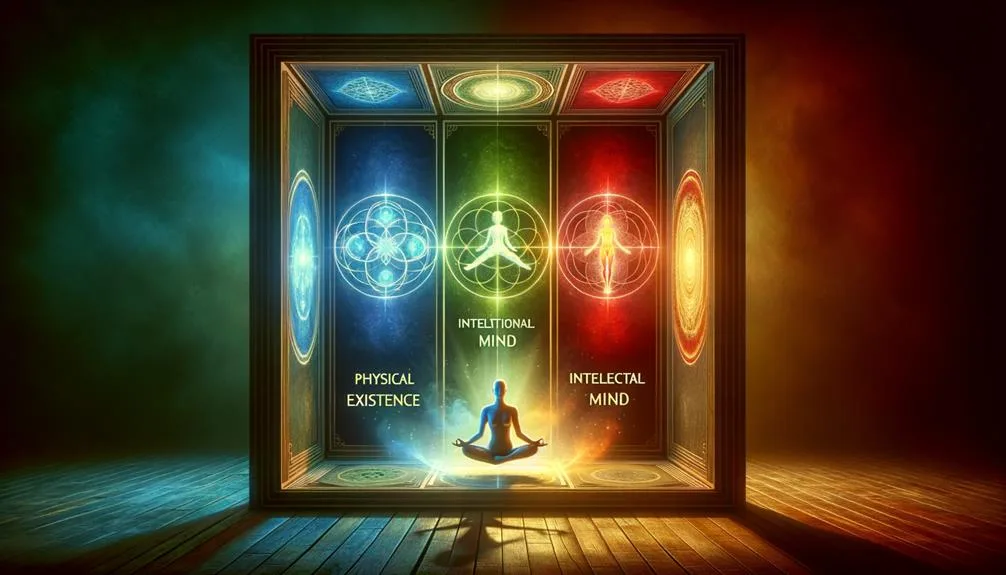As we tread softly through the serene landscape of mindfulness meditation, we're beckoned to uncover the profound teachings of the Four Foundations of Mindfulness. This ancient guide, laid out by the Buddha himself, offers us a map to navigate our inner worlds with heightened awareness and compassion.
We've found that by gently shifting our focus from the breath to the intricate workings of our minds and bodies, a deeper understanding of our existence begins to crystallize. It's within this exploration that we encounter the impermanent and unsatisfactory nature of life, not as a bleak revelation but as a liberating truth.
Join us as we peel back the layers of consciousness, uncovering insights that promise to transform our understanding of ourselves and the world around us.
Key Takeaways
- The Four Foundations of Mindfulness guide practitioners through body, feelings, mind, and dharma to deeper awareness.
- Practicing mindfulness meditation helps in realizing the impermanent and unsatisfactory nature of existence.
- Mindfulness of the body and feelings fosters understanding that neither are sources of lasting happiness, leading to detachment.
- The Four Foundations offer a structured path to achieving spiritual truth and freedom from suffering.
The Essence of Mindfulness
At the heart of mindfulness meditation lies the transformative practice of tuning into our present experiences with openness and without judgment. This mindful presence isn't just about being aware of our external environment; it's deeply rooted in cultivating an inner awareness that connects us more intimately with our thoughts, emotions, and sensations as they unfold moment by moment.
By engaging in this practice, we're not only learning to observe our experiences without clinging or aversion but also discovering a pathway to understanding ourselves on a profound level. This journey towards inner awareness fosters a sense of peace and equanimity, offering us a fresh perspective on life's challenges.
It's a compassionate invitation to be fully present, embracing each moment with a heart of acceptance.
Contemplating the Body
Building on our understanding of mindfulness as a pathway to inner awareness, we now explore the practice of contemplating the body to deepen our connection with the present moment. Here's how we can engage in this transformative practice:
- Body scan, breath observation: We start by directing our attention to our breath, then gradually move through each part of our body. This not only grounds us but also fosters a profound sense of presence.
- Impermanence realization: Through observing the body, we understand its transient nature. This insight helps us detach from identifying solely with our physical form.
- Lasting happiness pursuit: Recognizing the body's impermanence leads us to seek happiness beyond the physical. We learn to find joy in the deeper, unchanging aspects of our being.
Understanding Feelings

Delving into the realm of feelings, we discover that our emotional landscape is a complex tapestry of experiences that can teach us much about the transient nature of our existence. Exploring emotions allows us to see their fleeting nature and learn the art of managing reactions.
| Emotion Type | Insight Gained | Managing Reactions |
|---|---|---|
| Pleasant | Temporariness | Enjoy without clinging |
| Unpleasant | Not permanent | Respond, don't react |
| Neutral | Often overlooked | Observe with curiosity |
| Mixed | Complex nature | Acknowledge without judgment |
| Changing | Inconstant | Adapt with awareness |
We learn that our responses to these feelings can either perpetuate our suffering or lead us to deeper understanding and peace. By observing our feelings without attachment or aversion, we cultivate a mindful presence that enriches our experience of life.
Exploring the Mind
Having explored the fleeting nature of our feelings, we now turn our attention to the mind, a realm where thoughts and emotions intermingle, shaping our perception of reality. In mindfulness meditation, we seek insights that illuminate this complex landscape.
- Awareness of Thoughts: We learn to observe our thoughts without getting entangled in them. This detachment fosters a deeper understanding of our mental patterns.
- Embracing Emotions: Rather than suppressing or over-identifying with our emotions, we embrace them with kindness and curiosity, leading to profound mindfulness insights.
- Cultivating Presence: Through meditation practices, we enhance our ability to remain present, noticing the transient nature of our mental states without judgment.
In this exploration, we're not just discovering the mind's intricacies; we're learning to navigate its waters with grace and wisdom.
Unveiling Dharma Insights

In our journey through mindfulness meditation, we now turn our focus to the profound teachings of dharma, exploring its timeless insights into the nature of existence and our path toward liberation.
Diving deeper into these teachings, we're guided to a more profound understanding of the impermanent and interdependent nature of all things. Exploring awareness through the lens of dharma, we begin to see our experiences not as isolated events but as part of a larger, interconnected reality.
This realization fosters a sense of compassion and empathy, as we recognize that our struggles and joys are shared by all beings. By unveiling dharma insights, we're not just learning about mindfulness; we're embarking on a transformative journey that redefines our relationship with the world around us.
Frequently Asked Questions
How Does Mindfulness Meditation Differ From Other Forms of Meditation, Such as Transcendental Meditation or Guided Imagery?
We've found mindfulness meditation focuses more on personal experiences and the mind's present state, unlike transcendental meditation or guided imagery, which may rely on technique origins or structured visualizations for achieving a tranquil state.
Can Practicing the Four Foundations of Mindfulness Lead to Changes in Physical Health, and if So, How?
We believe practicing mindfulness can improve physical health. By focusing on biological mechanisms and lifestyle integration, we find stress decreases, leading to better health outcomes. It's about connecting body and mind for holistic well-being.
Are There Any Scientific Studies That Validate the Benefits of Practicing the Four Foundations of Mindfulness?
We've found studies confirming mindfulness's benefits, highlighting neuroplasticity research and measurement methodologies. These insights show how such practices can reshape our brains, offering empathy and structure to those seeking to understand their profound effects.
How Can Someone Who Struggles With Sitting Still or Focusing for Long Periods Begin to Practice Mindfulness Meditation Effectively?
We've found walking meditation and micro practices incredibly helpful for those of us who find sitting still challenging. These methods allow us to gradually build focus and mindfulness in more accessible, bite-sized sessions.
What Role Does Mindfulness Meditation Play in Different Religious or Spiritual Traditions Outside of Buddhism?
We've discovered that mindfulness, like a tree, has roots in Buddhism but branches out widely. Its spiritual integration across various traditions demonstrates mindfulness origins' universal appeal, offering a shared path to inner peace and understanding.
Conclusion
In our journey through the Four Foundations of Mindfulness, we've walked a mile in ancient footsteps, uncovering the essence of our existence. By contemplating our bodies, understanding our feelings, exploring our minds, and unveiling dharma insights, we've seen the impermanent and unsatisfactory nature of life.
This path hasn't been a bed of roses, but it's led us to a deeper freedom and truth. Together, we've learned to live more fully, embracing each moment with open hearts and minds.

